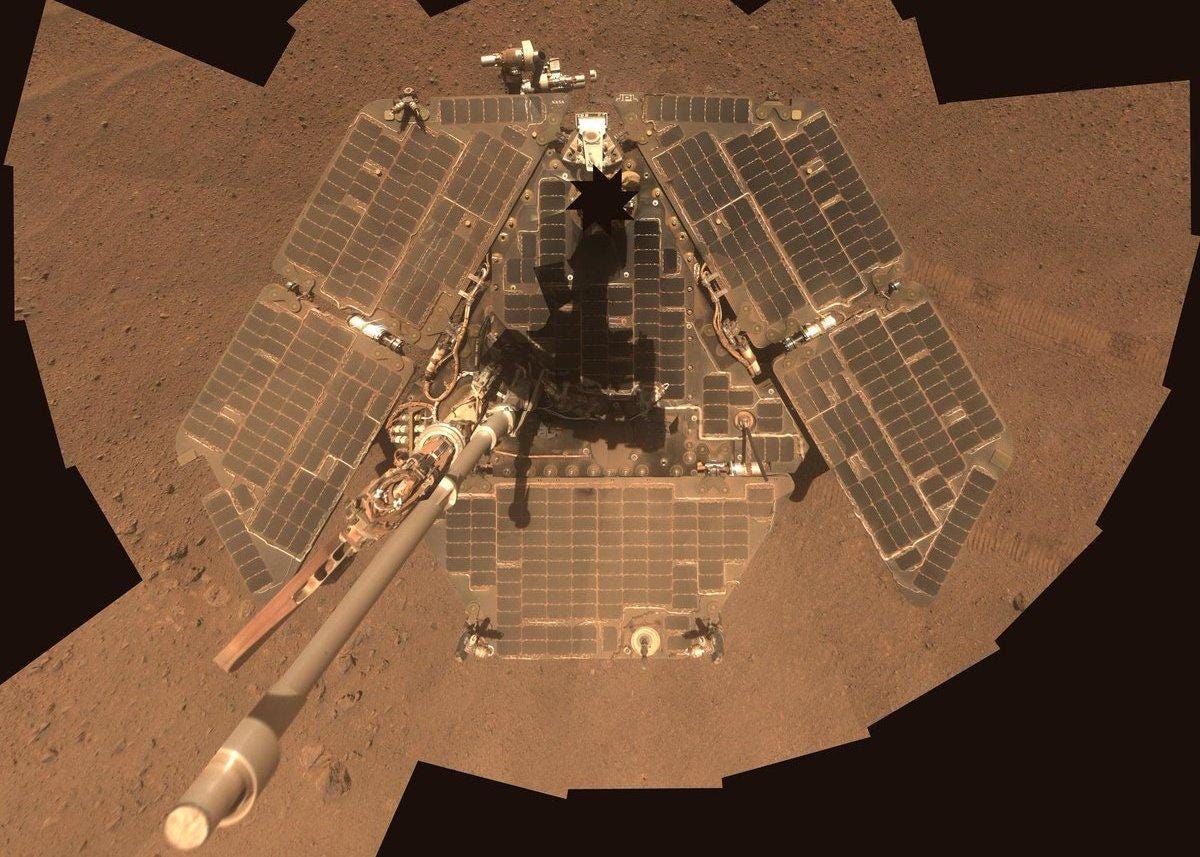NASA Opportunity rover witnessed the wild side of Mars
See what the rover saw. In 15 years on Mars, Oppy caught sight of meteorites, "blueberries," a "jelly doughnut" and other exotic rock formations.

Opportunity explores Mars
NASA landed the solar-powered Opportunity rover on Mars in 2004 and it outlasted its original three-month mission timeline by many, many years. The space agency officially declared Opportunity's mission over on Feb. 13, 2019 after last-ditch communication efforts failed.
Opportunity snapped this mosaic in 2011 after winds cleaned dust off its solar panels.
The dust turned out to be problem for Oppy in June 2018 when a global dust storm caused it to go silent, leaving NASA out of touch with its longest-lived Mars rover.
Lander leftovers
This is the lander that delivered the Opportunity rover safely to Mars in 2004. Oppy snapped the images that make up this mosaic view on its 24th Martian day. NASA processed the image to make it look like what the human eye would see.
oppylandertrench
In 2004, not long after landing on Mars, Opportunity dug this trench near the lander hardware that delivered it to the planet's surface. The rover's wheel exposed subsurface material. The white material is the fabric ramp Opportunity used to reach the surface. The rover's robotic arm instruments are near the middle.
Blueberries
There's nothing edible here. These hematite-rich spherules are known by the cute nickname "blueberries." NASA's Mars Opportunity rover spotted the small, BB-pellet-size pebbles in 2004 near the Fram Crater.
Rock abrasion
Opportunity turned its rock abrasion tool onto this target named "Gagarin" in 2005. This false-color image highlights the 1.8-inch (4.5-centimeter) round mark created by the tool.
Opportunity gets a selfie
NASA's older Opportunity rover has been on the Red Planet a lot longer than its younger cousin Curiosity. Oppy got in on the selfie trend in early 2018 with this self-portrait celebrating its 5,000th day on Mars. It's not as refined as Curiosity's selfies, but it's perfectly charming in its own right.
Meteorite up close
This meteorite came under scrutiny from the Opportunity rover in 2010. This false-color view really makes it stand out. The rover's science instruments helped NASA confirm that it is indeed a nickel-iron meteorite.
Opportunity on Mars
Look for the speck in the center of the square. That's the Opportunity rover as seen by NASA's Mars Reconnaissance Orbiter in late 2018, after the machine went silent.
Bright rock
Opportunity captured a look at this fascinating rock, named "Private Joseph Field," in 2016 while exploring Marathon Valley at the western rim of the Endeavour Crater on Mars. The bright rock is actually just a fraction of an inch across. Field was a member of the Lewis and Clark Expedition of the early 1800s.
Dust devil
Mars is dusty and windy and it's a perfect place to spot dust devils. Opportunity looked back towards its own tracks in 2016 and snapped a photo of a dust devil hightailing it across the planet.
Iron meteorite
In 2005, NASA announced that the Mars Exploration Rover Opportunity had found an iron meteorite the size of a basketball. The space agency named it "Heat Shield Rock" since it is located near the heat shield debris from the rover's landing in 2004.
Jelly doughnut?
A mysterious doughnut-shaped rock appeared in Opportunity's field of view in early 2014. It was not seen in a previous look at the same spot. The seeming magic trick turned out to have a mundane explanation when NASA figured out it was a piece of a rock the rover drove over.
Oppy spies an outcrop
The Opportunity rover investigated this noticeably bright outcrop on the western edge of the Endeavour Crater in late 2016. NASA enhanced the color of the image to highlight the different materials in the outcrop. This view covers an area of less than 2 inches (5 centimeters). Scientists think the outcrop may have been formed by the impact that created the massive crater.
Leaving tracks
The Opportunity rover skirted the edge of a small crater in 2017 and took a moment to look back at its own tracks on the surface of Mars.
Oppy spots a meteorite
Opportunity eyed this apparent meteorite in 2009. NASA nicknamed the space rock "Shelter Island." It is 18.5 inches (47 centimeters) long.
NASA Opportunity rover illustration
While Opportunity has snapped some selfies on Mars, this NASA illustration gives us an idea of what it looks like on the surface of the Red Planet.
Lonesome view
Opportunity looked out over an expansive and desolate landscape in this 2010 mosaic showing the rover's view of Mars. The bedrock is lighter, while the sand is darker. Look closely and you can see ripples in the sand created by the wind.

